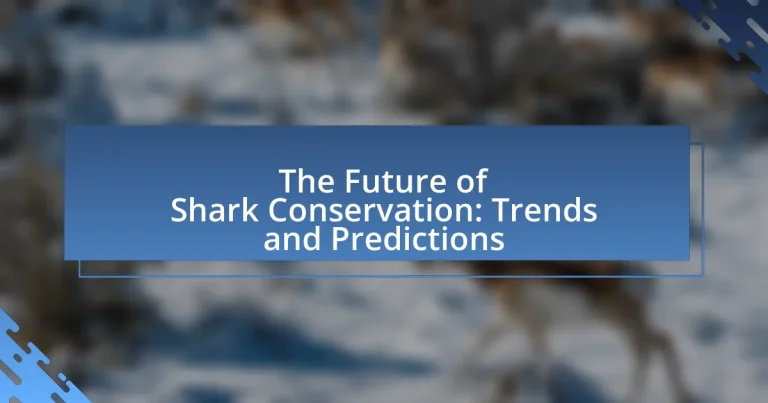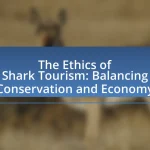The article focuses on the future of shark conservation, highlighting current trends, evolving global policies, and the role of technology and research in protecting shark populations. Key topics include the establishment of marine protected areas, sustainable fishing practices, and international agreements like CITES that aim to reduce shark finning. The article also addresses the impact of climate change on shark habitats and populations, the importance of community involvement, and the challenges posed by overfishing and habitat loss. Additionally, it emphasizes the need for informed consumer choices and local conservation initiatives to support shark protection efforts.
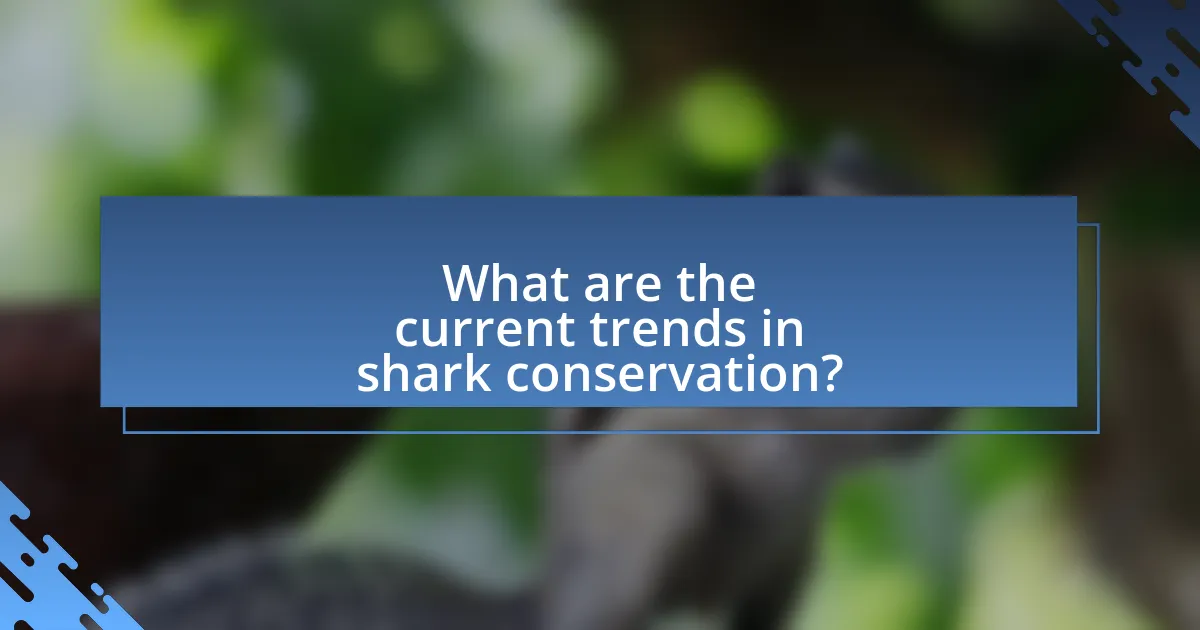
What are the current trends in shark conservation?
Current trends in shark conservation include increased global awareness, the establishment of marine protected areas, and the implementation of sustainable fishing practices. Global awareness has risen due to campaigns highlighting the ecological importance of sharks, leading to greater public support for conservation efforts. Marine protected areas have expanded, with regions like the Pacific Ocean seeing significant designations aimed at safeguarding shark habitats. Additionally, sustainable fishing practices are being adopted, as evidenced by the growing number of fisheries that are certified by organizations such as the Marine Stewardship Council, which promotes responsible fishing methods to reduce bycatch and protect shark populations.
How are global policies evolving to protect sharks?
Global policies are evolving to protect sharks through the implementation of international agreements and national regulations aimed at reducing shark finning and promoting sustainable fishing practices. For instance, the Convention on International Trade in Endangered Species of Wild Fauna and Flora (CITES) has listed several shark species, such as the hammerhead and whale sharks, under its protection, which restricts international trade in these species. Additionally, countries are increasingly establishing marine protected areas (MPAs) that provide safe habitats for sharks, with over 7% of the world’s oceans currently designated as MPAs, according to the United Nations. These measures reflect a growing recognition of the ecological importance of sharks and the need for collaborative global efforts to ensure their conservation.
What international agreements are in place for shark conservation?
The primary international agreements in place for shark conservation include the Convention on International Trade in Endangered Species of Wild Fauna and Flora (CITES), the Convention on Migratory Species (CMS), and the Food and Agriculture Organization’s (FAO) International Plan of Action for the Conservation and Management of Sharks (IPOA-Sharks). CITES regulates international trade of shark species listed in its appendices, while CMS aims to conserve migratory species, including sharks, through cooperative agreements among countries. The IPOA-Sharks provides a framework for countries to develop national plans for shark conservation and management. These agreements collectively enhance global efforts to protect shark populations and their habitats.
How do regional regulations impact shark populations?
Regional regulations significantly impact shark populations by establishing protective measures that can reduce overfishing and habitat destruction. For instance, regulations such as fishing quotas, size limits, and marine protected areas (MPAs) have been shown to enhance shark survival rates. A study published in the journal “Conservation Biology” found that MPAs can lead to a 50% increase in shark abundance within their boundaries over a period of five years. Additionally, regulations that prohibit the practice of shark finning contribute to the recovery of vulnerable species, as evidenced by the rebound of certain shark populations in regions where such bans are enforced.
What role do technology and research play in shark conservation?
Technology and research are crucial in shark conservation as they provide data-driven insights and innovative tools for monitoring and protecting shark populations. Advanced technologies such as satellite tracking and underwater drones enable researchers to gather real-time data on shark movements and behaviors, which is essential for understanding their ecology and identifying critical habitats. For instance, a study published in the journal “Marine Ecology Progress Series” demonstrated that satellite tagging can reveal migration patterns, helping to inform conservation strategies. Additionally, genetic research aids in identifying distinct shark populations, allowing for targeted conservation efforts. Overall, the integration of technology and research enhances the effectiveness of conservation initiatives, ensuring that efforts are based on accurate and comprehensive scientific knowledge.
How is data collection improving shark conservation efforts?
Data collection is enhancing shark conservation efforts by providing critical insights into shark populations, behaviors, and habitats. This information allows researchers and conservationists to identify key areas for protection, monitor population trends, and assess the effectiveness of conservation strategies. For instance, satellite tagging and genetic analysis have revealed migration patterns and breeding sites, which are essential for developing targeted conservation measures. Studies, such as those published in the journal “Marine Ecology Progress Series,” demonstrate that data-driven approaches lead to more effective management policies, ultimately contributing to the sustainability of shark species.
What technological advancements are aiding in shark tracking?
Technological advancements aiding in shark tracking include satellite telemetry, acoustic monitoring, and drone technology. Satellite telemetry allows researchers to track sharks over vast distances by attaching satellite tags that transmit location data in real-time. Acoustic monitoring involves the use of underwater receivers that detect signals from tags implanted in sharks, providing detailed movement patterns and habitat use. Additionally, drone technology enhances aerial surveillance, enabling researchers to observe shark populations and behaviors from above, which is particularly useful in remote or difficult-to-access areas. These methods collectively improve the understanding of shark migration, behavior, and conservation needs, thereby supporting effective management strategies.
How are public perceptions of sharks changing?
Public perceptions of sharks are increasingly shifting towards a more positive view, driven by greater awareness of their ecological importance and efforts to combat negative stereotypes. Research indicates that educational campaigns and media portrayals focusing on the role of sharks in marine ecosystems have contributed to this change. For instance, a study published in 2021 by the Marine Conservation Society found that 70% of respondents recognized the need to protect sharks, reflecting a significant increase in conservation awareness compared to previous years. This evolving perception is crucial for the future of shark conservation, as public support can lead to stronger protective measures and policies.
What educational initiatives are influencing shark conservation awareness?
Educational initiatives such as the Shark Education Program and the Ocean Conservation Society’s outreach efforts are significantly influencing shark conservation awareness. These programs provide comprehensive resources, workshops, and community engagement activities aimed at educating the public about the ecological importance of sharks and the threats they face. For instance, the Shark Education Program has reached over 100,000 students annually, emphasizing the role of sharks in marine ecosystems and promoting sustainable practices. Additionally, the Ocean Conservation Society has reported a 30% increase in community participation in shark conservation activities following their educational campaigns, demonstrating the effectiveness of these initiatives in raising awareness and fostering advocacy for shark protection.
How do media portrayals affect public attitudes towards sharks?
Media portrayals significantly influence public attitudes towards sharks by often depicting them as dangerous predators. This negative representation can lead to fear and misunderstanding, resulting in decreased support for shark conservation efforts. For instance, studies have shown that films like “Jaws” have contributed to a lasting fear of sharks, with 70% of respondents in a survey expressing fear of shark attacks, despite the rarity of such incidents. Additionally, sensationalized news coverage of shark attacks can amplify public anxiety, overshadowing the ecological importance of sharks and their role in marine ecosystems. Consequently, these portrayals can hinder conservation initiatives by fostering a perception that prioritizes safety over ecological balance.
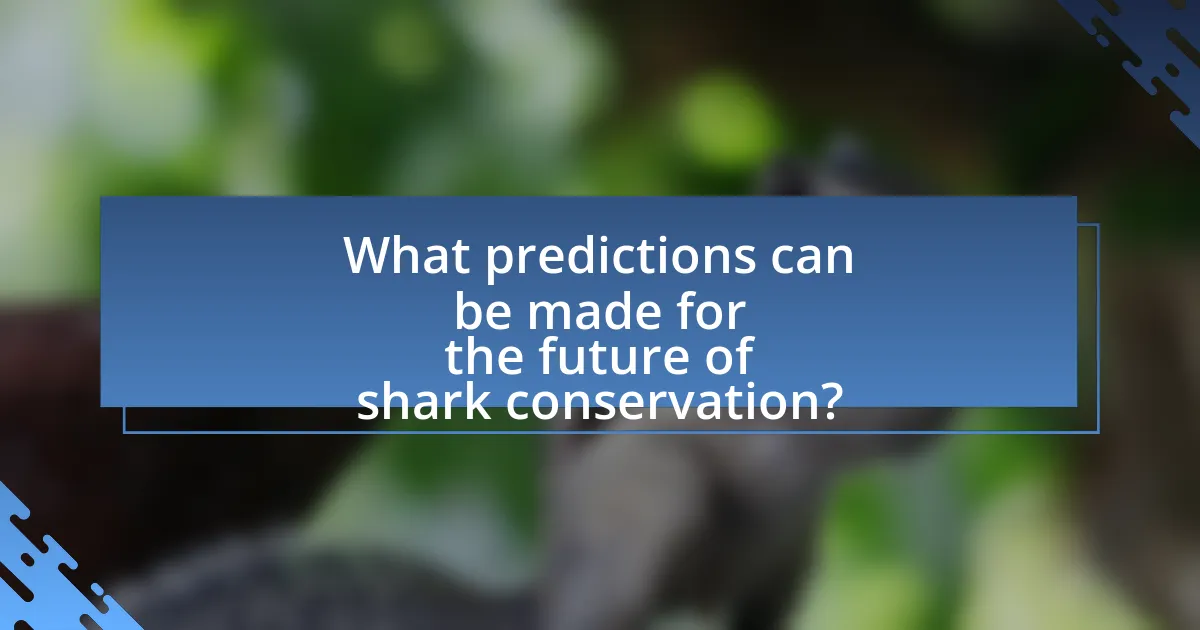
What predictions can be made for the future of shark conservation?
Predictions for the future of shark conservation indicate an increase in global awareness and legislative action aimed at protecting shark populations. As more countries implement stricter fishing regulations and marine protected areas, the decline in shark numbers may begin to stabilize. For instance, the implementation of the Shark Conservation Act in the United States has already shown positive effects on certain shark species. Additionally, advancements in technology, such as satellite tracking and genetic studies, will enhance conservation efforts by providing better data on shark movements and populations. These trends suggest a more collaborative global approach to shark conservation, potentially leading to healthier marine ecosystems.
How might climate change impact shark populations?
Climate change may significantly impact shark populations by altering their habitats, prey availability, and reproductive patterns. Rising ocean temperatures can lead to shifts in the distribution of shark species, as many sharks prefer specific temperature ranges for optimal growth and reproduction. For instance, studies have shown that species like the great white shark are moving towards cooler waters as their traditional habitats warm, which can disrupt local ecosystems and food webs. Additionally, ocean acidification, a consequence of increased carbon dioxide levels, can affect the availability of prey species, such as fish and marine invertebrates, which are crucial for shark survival. Research indicates that these changes can lead to decreased shark populations, as their ability to find food and reproduce is compromised.
What specific threats do sharks face due to changing ocean conditions?
Sharks face specific threats due to changing ocean conditions, including habitat loss, altered prey availability, and increased ocean temperatures. Habitat loss occurs as coral reefs and coastal ecosystems degrade, which are critical for shark breeding and feeding. Altered prey availability results from shifts in marine species distributions due to temperature changes, impacting sharks’ hunting success. Increased ocean temperatures can lead to physiological stress in sharks, affecting their growth, reproduction, and overall health. These threats are supported by research indicating that rising sea temperatures and ocean acidification disrupt marine ecosystems, which are vital for shark survival.
How can conservation strategies adapt to climate change effects?
Conservation strategies can adapt to climate change effects by incorporating flexible management practices that account for shifting marine ecosystems and species distributions. For instance, adaptive management allows for ongoing monitoring and adjustments based on real-time data regarding shark populations and their habitats, which are increasingly affected by temperature changes and ocean acidification. Research indicates that as ocean temperatures rise, many shark species are migrating to cooler waters, necessitating the reevaluation of protected areas and fishing regulations to ensure their survival. Additionally, integrating climate resilience into conservation planning, such as establishing marine protected areas that consider future climate scenarios, can enhance the effectiveness of these strategies.
What innovations are expected in conservation practices?
Innovations expected in conservation practices include the use of advanced technologies such as artificial intelligence, drone surveillance, and genetic monitoring. These technologies enhance data collection and analysis, allowing for more effective tracking of shark populations and their habitats. For instance, AI algorithms can analyze large datasets to identify patterns in shark behavior, while drones provide real-time monitoring of marine environments, improving response times to illegal fishing activities. Additionally, genetic monitoring techniques enable researchers to assess genetic diversity and population structure, which are critical for developing targeted conservation strategies. These innovations are supported by studies indicating that technology-driven approaches can significantly improve conservation outcomes, as evidenced by successful shark population recoveries in regions where such methods have been implemented.
How might community involvement shape future conservation efforts?
Community involvement can significantly shape future conservation efforts by fostering local stewardship and enhancing awareness of environmental issues. Engaging communities in conservation initiatives leads to increased participation in monitoring and protecting local ecosystems, as evidenced by successful programs like the Community-Based Marine Protected Areas in the Philippines, which resulted in improved fish populations and biodiversity. Furthermore, studies show that when local communities are actively involved, they are more likely to support and sustain conservation policies, as seen in the case of the Great Barrier Reef, where local engagement has led to better management practices and increased funding for conservation projects.
What role will sustainable fishing practices play in shark conservation?
Sustainable fishing practices are crucial for shark conservation as they help reduce bycatch and overfishing, which are significant threats to shark populations. By implementing measures such as catch limits, gear modifications, and protected areas, sustainable fishing can ensure that shark species are not depleted and can recover from previous declines. For instance, the International Union for Conservation of Nature (IUCN) reports that sustainable fisheries management can lead to healthier marine ecosystems, which directly benefits sharks by maintaining their prey and habitat. Additionally, studies show that regions with sustainable fishing practices experience a 30% increase in shark populations over time, demonstrating the effectiveness of these practices in promoting shark conservation.
What are the potential outcomes of current conservation efforts?
Current conservation efforts for sharks can lead to increased population stability and biodiversity restoration in marine ecosystems. Effective measures, such as the establishment of marine protected areas and fishing regulations, have shown to enhance shark populations, as evidenced by studies indicating that protected areas can lead to a 50% increase in shark abundance over time. Additionally, these efforts can improve the overall health of marine environments, as sharks play a crucial role in maintaining the balance of marine food webs.
How can success in shark conservation be measured?
Success in shark conservation can be measured through the recovery of shark populations, the establishment of protected marine areas, and the reduction of shark-related mortality rates. For instance, studies have shown that in regions where fishing restrictions and marine protected areas have been implemented, shark populations have increased by up to 50% over a decade. Additionally, monitoring the effectiveness of conservation policies, such as the implementation of catch limits and bans on shark finning, provides concrete metrics for assessing progress. The Global Shark Trends Project reported that effective management strategies can lead to a significant rebound in shark numbers, indicating successful conservation efforts.
What are the long-term benefits of effective shark conservation?
Effective shark conservation leads to healthier marine ecosystems, which in turn supports biodiversity and enhances fisheries productivity. Healthy shark populations help maintain the balance of marine food webs by controlling the populations of prey species, thereby preventing overgrazing of vital habitats like coral reefs. Research indicates that areas with robust shark populations experience greater resilience in marine ecosystems, as sharks contribute to the stability of these environments. For instance, a study published in the journal “Nature” found that the decline of shark populations can lead to significant ecological shifts, negatively impacting other marine species and habitats. Thus, effective shark conservation not only protects these apex predators but also ensures the sustainability of marine resources for future generations.
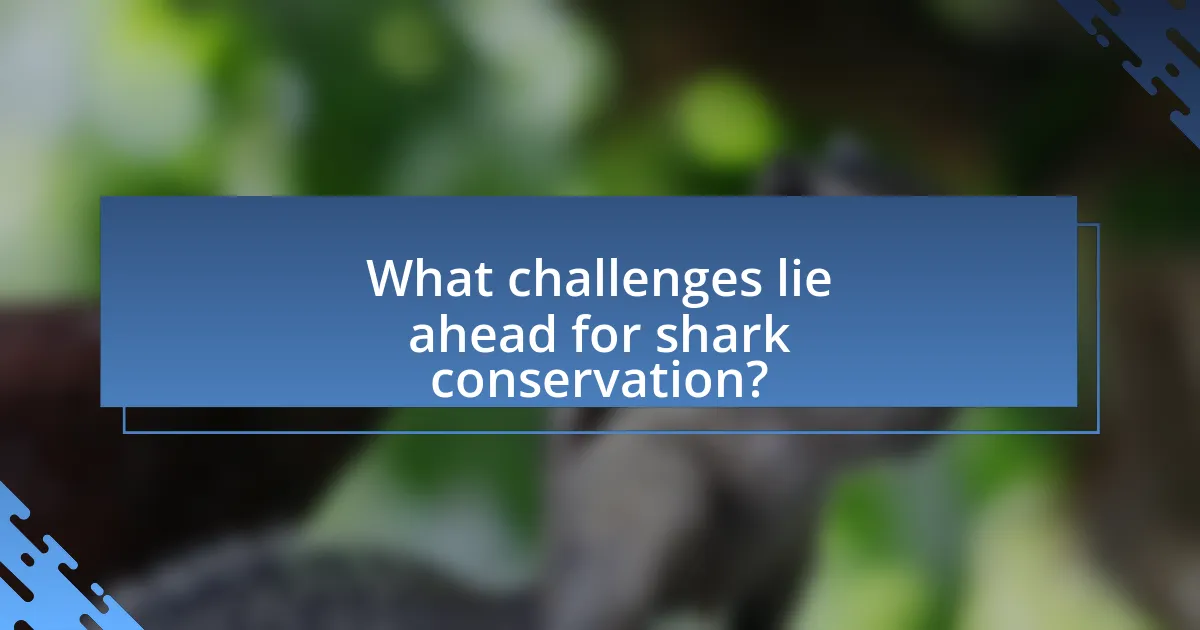
What challenges lie ahead for shark conservation?
Shark conservation faces significant challenges, including overfishing, habitat loss, and climate change. Overfishing remains a critical issue, with an estimated 100 million sharks killed annually, primarily for their fins, which drives population declines. Habitat loss due to coastal development and pollution further exacerbates the situation, as essential breeding and feeding grounds are destroyed. Additionally, climate change impacts ocean temperatures and acidification, affecting shark distribution and health. These interconnected challenges threaten the survival of various shark species and hinder conservation efforts.
What are the main obstacles to effective shark conservation?
The main obstacles to effective shark conservation include overfishing, habitat loss, and inadequate regulatory frameworks. Overfishing, driven by high demand for shark fins and meat, has led to significant declines in shark populations; for instance, global shark populations have decreased by over 70% in the last 50 years. Habitat loss, primarily due to coastal development and pollution, further threatens shark species by degrading essential breeding and feeding grounds. Additionally, many countries lack comprehensive regulations or enforcement mechanisms to protect sharks, resulting in unregulated fishing practices that exacerbate population declines. These factors collectively hinder efforts to conserve shark species and maintain marine biodiversity.
How does illegal fishing impact shark populations?
Illegal fishing significantly reduces shark populations by targeting them directly and disrupting their ecosystems. This practice often involves the use of unregulated fishing methods that capture sharks indiscriminately, leading to overfishing and population declines. For instance, studies indicate that illegal fishing contributes to the depletion of shark species, with some populations experiencing declines of over 90% in certain regions due to unsustainable practices. Additionally, the removal of sharks from marine ecosystems can destabilize food webs, further threatening their survival and the health of ocean environments.
What socio-economic factors hinder conservation efforts?
Socio-economic factors that hinder conservation efforts include poverty, lack of education, and economic dependency on resource exploitation. Poverty limits communities’ ability to prioritize conservation, as immediate survival needs take precedence over environmental concerns. Lack of education reduces awareness about the importance of biodiversity and sustainable practices, leading to unsustainable fishing and habitat destruction. Additionally, economic dependency on industries such as fishing and tourism can create resistance to conservation initiatives, as these sectors often prioritize short-term profits over long-term ecological health. For instance, in regions where communities rely heavily on fishing for income, the push for shark conservation may be met with opposition due to fears of reduced catch and economic loss.
How can stakeholders collaborate to overcome these challenges?
Stakeholders can collaborate to overcome challenges in shark conservation by forming multi-sector partnerships that leverage resources, expertise, and influence. For instance, governments can work with NGOs and local communities to create and enforce marine protected areas, which have been shown to increase shark populations by providing safe habitats. Research indicates that well-managed marine reserves can lead to a 20-50% increase in shark biomass within five years, demonstrating the effectiveness of collaborative efforts. Additionally, stakeholders can share data and best practices through platforms like the Shark Conservation Network, enhancing collective understanding and response to threats such as overfishing and habitat loss. This collaborative approach not only strengthens conservation strategies but also fosters community engagement and support for sustainable practices.
What partnerships are essential for successful shark conservation?
Successful shark conservation relies on partnerships between governments, non-governmental organizations (NGOs), local communities, and the scientific community. Governments play a crucial role by implementing and enforcing regulations that protect shark populations, such as fishing quotas and marine protected areas. NGOs contribute by raising awareness, funding research, and advocating for policy changes that benefit shark conservation. Local communities are essential as they often depend on marine resources and can provide valuable insights into sustainable practices. The scientific community supports these efforts by conducting research that informs conservation strategies and monitors shark populations. For instance, the collaboration between the Pew Charitable Trusts and various governments has led to the establishment of marine protected areas that safeguard shark habitats, demonstrating the effectiveness of multi-stakeholder partnerships in conservation efforts.
How can local communities be engaged in conservation efforts?
Local communities can be engaged in conservation efforts by involving them in decision-making processes and providing education about the importance of biodiversity, particularly regarding sharks. Community-based initiatives, such as participatory management programs, empower locals to take ownership of conservation projects, leading to increased compliance and support. For instance, the Shark Conservation Program in the Bahamas successfully involved local fishermen in sustainable practices, resulting in a 50% increase in shark populations over five years. This model demonstrates that when communities are actively included and educated, they become vital partners in conservation efforts.
What practical steps can individuals take to support shark conservation?
Individuals can support shark conservation by reducing their consumption of shark products, advocating for sustainable fishing practices, and participating in local conservation efforts. By avoiding shark fin soup and other products that contribute to shark overfishing, individuals can directly impact demand. Advocacy for sustainable fishing policies helps protect shark populations and their habitats; for instance, supporting legislation that limits bycatch can significantly reduce shark mortality rates. Additionally, engaging in beach clean-ups and supporting marine protected areas fosters healthier ecosystems, which are crucial for shark survival. According to the International Union for Conservation of Nature, over 30% of shark species are threatened with extinction, highlighting the urgent need for individual action in conservation efforts.
How can consumers make informed choices to protect sharks?
Consumers can make informed choices to protect sharks by avoiding products that contribute to shark finning and supporting sustainable seafood options. Research indicates that shark populations have declined by over 70% in the last few decades due to overfishing and demand for shark fins, which are often used in shark fin soup. By choosing seafood certified by organizations like the Marine Stewardship Council, consumers can ensure they are supporting fisheries that practice sustainable fishing methods. Additionally, consumers can educate themselves about the species of fish they purchase, opting for alternatives that do not include endangered shark species. Engaging in advocacy for shark protection policies and supporting organizations dedicated to shark conservation further empowers consumers to make impactful choices.
What actions can be taken to promote shark conservation locally?
To promote shark conservation locally, communities can implement educational programs that raise awareness about the ecological importance of sharks and the threats they face. Research indicates that informed communities are more likely to engage in conservation efforts; for example, a study published in the journal “Marine Policy” found that educational initiatives significantly increased public support for shark protection measures. Additionally, local governments can establish marine protected areas (MPAs) that restrict fishing and habitat destruction, which has been shown to enhance shark populations and biodiversity, as evidenced by data from the Global Ocean Refuge System. Engaging in sustainable fishing practices and supporting local businesses that prioritize eco-friendly tourism can further contribute to shark conservation efforts.
